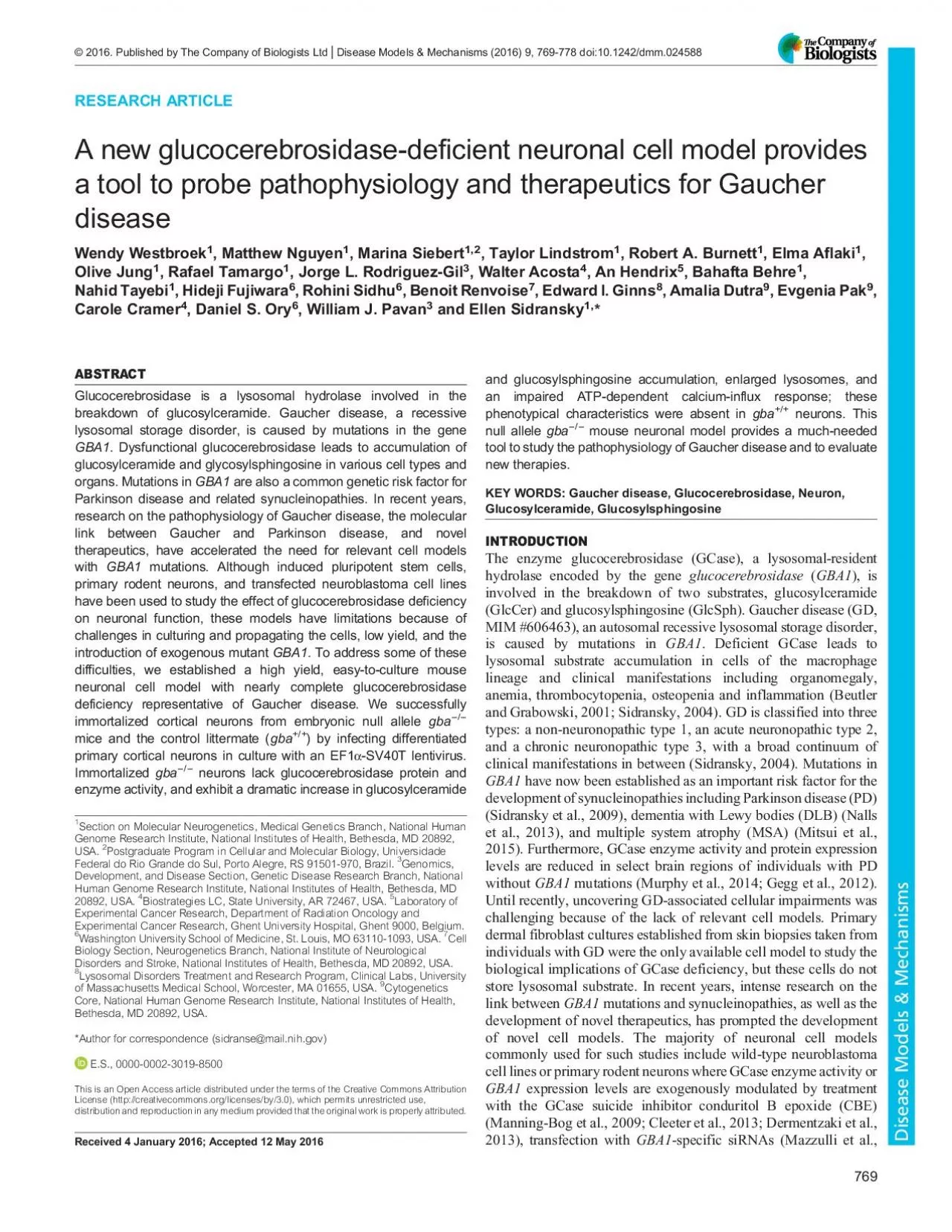

Received4January2016Accepted12May2016 SectiononMolecularNeurogeneticsMedicalGeneticsBranchNationalHumanGenomeResearchInstituteNationalInstitutesofHealthBethesdaMD20892 ES0000000230198500T ID: 958880
Download Pdf The PPT/PDF document "RESEARCHARTICLEAnewglucocerebrosidasedef..." is the property of its rightful owner. Permission is granted to download and print the materials on this web site for personal, non-commercial use only, and to display it on your personal computer provided you do not modify the materials and that you retain all copyright notices contained in the materials. By downloading content from our website, you accept the terms of this agreement.
RESEARCHARTICLEAnewglucocerebrosidase-deficientneuronalcellmodelprovidesatooltoprobepathophysiologyandtherapeuticsforGaucherWendyWestbroek,MatthewNguyen,MarinaSiebert1,2,TaylorLindstrom,RobertA.Burnett,ElmaAflakiOliveJung,RafaelTamargo,JorgeL.Rodriguez-Gil,WalterAcosta,AnHendrix,BahaftaBehreNahidTayebi,HidejiFujiwara,RohiniSidhu,BenoitRenvoise,EdwardI.Ginns,AmaliaDutra,EvgeniaPakCaroleCramer,DanielS.Ory,WilliamJ.PavanandEllenSidranskyABSTRACTGlucocerebrosidaseisalysosomalhydrolaseinvolvedinthebreakdownofglucosylceramide.Gaucherdisease,arecessivelysosomalstoragedisorder,iscausedbymutationsinthegene.Dysfunctionalglucocerebrosidaseleadstoaccumulationofglucosylceramideandglycosylsphingosineinvariouscelltypesandorgans.MutationsinarealsoacommongeneticriskfactorforParkinsondiseaseandrelatedsynucleinopathies.Inrecentyears,researchonthepathophysiologyofGaucherdisease,themolecularlinkbetweenGaucherandParkinsondisease,andnoveltherapeutics,haveacceleratedtheneedforrelevantc
ellmodels Received4January2016;Accepted12May2016 SectiononMolecularNeurogenetics,MedicalGeneticsBranch,NationalHumanGenomeResearchInstitute,NationalInstitutesofHealth,Bethesda,MD20892, E.S.,0000-0002-3019-8500ThisisanOpenAccessarticledistributedunderthetermsoftheCreativeCommonsAttributionLicense(http://creativecommons.org/licenses/by/3.0),whichpermitsunrestricteduse,distributionandreproductioninanymediumprovidedthattheoriginalworkisproperlyattributed. ©2016.PublishedbyTheCompanyofBiologistsLtdDiseaseModels&Mechanisms(2016)9,769-778doi:10.1242/dmm.024588 DiseaseModels&Mechanisms 2011),orover-expressionofplasmidscontainingmutantGBA1(Cullenetal.,2011).Althoughthesemodelshaveprovenuseful,exogenousmanipulationofGCaseorexpressionoftencreatesunwantedoff-targeteffects.PrimaryneuronalculturesfromonemousemodelwereusedtoprobemitochondrialfunctioninGD(OsellameandDuchen,2013;Osellameetal.,2013).Recently,thedevelopmentofinducedpluripotentstemcell(iPSC)linesfromGDpatientsandca
rriershasgainedpopularity,providingtheopportunitytodevelopcellculturesofpreviouslyinaccessiblediseasedhumanneurons(Tiscorniaetal.,2013;Woodardetal.,2014;Sunetal.,2015;Schondorfetal.,2014;Awadetal.,2015).ThemaindisadvantagesofbothprimaryrodentneuronalculturesandiPSC-generatedneuronsarelowcellcultureyieldandthelabor-intensivenessofestablishmentandmaintenance.WehypothesizedthatimmortalizedGDneuronsderivedfromaGDmousemodelcouldprovideahigh-yield,easy-to-maintainalternativeforinvestigationsofthecellularmechanismsinvolvedinGD.Suchimmortalizedneuronscouldalsohaveutilityfortheevaluationofnoveltherapeuticsandthevalidationofdifferentreagentsandantibodies.ImmortalizationofprimarycellsisaccomplishedbyexogenousintroductionofimmortalizinggenessuchastheSV40largeTantigen(SV40-T),whichincreaseslifespanandinducesunlimitedproliferationbyinactivationofthecell-cyclesuppressorspRb,SEN6andp53(Ozeretal.,1996;Tevethiaetal.,1998;ManfrediandPrives,1994;Ozer,2000;Jhaetal.,1998).Neuronsaret
erminallydifferentiatedpost-mitoticcells,whichmakesgenedeliveryviatraditionaltransfectionmethodsdifficult.Lentiviralexpressionvectorshavetheabilitytotransduceproliferatingandnon-proliferatingcells,andhavebeenusedforinfectionofprimaryrodentneuronalcultures(Lewisetal.,1992;Weinbergetal.,1991;Zhangetal.,2006;DingandKilpatrick,2013;Eleftheriadouetal.,2014;Lietal.,2012).Inthisstudy,wereportthesuccessfulSV40-T-mediatedimmortalizationofmousecorticalneuronsderivedfromapreviouslyestablishedmousemodeldeficientinmurineglucocerebrosidase(Tybulewiczetal.,1992).RESULTSTheEF1promotordrivesexpressioninculturedmousecorticalcellsSeveralindependentstudiesestablishedthatpromotordeterminationforoptimalgeneexpressioninaspecificcelltypeisbeneficial(Dayetal.,2009;Tsuchiyaetal.,2002).Therefore,wetestedapanelofeightdifferentpromotersfusedtoenhancedgreenfluorescentprotein(eGFP)fortheirexpressioncapacityinC57BL/6primarymouseneuronalcultures(Table1).Brainsfrom17EC57BL/6embryoswereharvesteda
ndneuronalcultureswereestablished.Six-day-oldprimaryembryoniccorticalneuronalculturesweretransducedwithlentiviruscontainingrecombinantgenesencodingmPol2,Grp78,FerH,CAG,CMV13,PGK,EF1orTRE-TightfusedtoeGFP.WeidentifiedtheEF1promotorasanoptimalpromoterforprimarymousecorticalcellswithrobusteGFPexpressionfivedaysafterinfectionatmultiplicityofinfection(MOI)40(Fig.1A).Atthispoint,theinfectedprimarymousecorticalcellculturesconsistofamixedpopulationofneuronsandglialcells.OurfindingswereinagreementwithpreviousstudieswhereEF1wasidentifiedasasuitablepromoterforexpressioninratcorticalcellculturesandmouseneuralprecursorcells(Tsuchiyaetal.,2002;Zengetal.,2003).EF1-drivenexpressionofSV40-TimmortalizesprimarycorticalmousecellsExogenousintroductionoftheimmortalizinggeneknowntoinduceproliferationandincreaselife-spanbyinactivationofkeycell-cyclesuppressors(Ozeretal.,1996;Tevethiaetal.,1998;ManfrediandPrives,1994;Ozer,2000;Jhaetal.,1998).Culturesofprimaryembryoniccorticalcellswerees
tablishedfromapreviouslydescribedmousemodelrepresentativeoftype2GD(Tybulewiczetal.,1992).Six-day-oldculturesofcorticalcellswereinfectedwithEF1-SV40-TlentivirusatMOI40.Fivedaysafterinfection,SV40-Texpressingcellswereselectedbytreatingwithpuromycinforfourweeks.Afterselection,theimmortalizedcorticalcellcultureswerepassagedandexpressionofSV40-Twasconfirmedinproteinlysatesofimmortalizedculturesofeachgenotypebywesternblotting(Fig.1B).LaserscanningconfocalmicroscopyoncellsstainedwithanuclearDAPIstain(Fig.1D,E)andananti-SV40Tantibody(Fig.1F,G)revealedlocalizationofSV40-Tinthenucleus(Fig.1H,I)inimmortalizedneuronsofbothgenotypes.ToinvestigatewhetherSV40-Texpressioninducesinvivotumorgrowth,weperformedintraperitonealinjectionwith10cellsofeachgenotypeinSwissnu/numiceandmonitoredtumorformation.Allmicedisplayedvisibletumorsfourweeksafterinjection(Fig.1C).EstablishmentofCD24-positiveimmortalizedneuronsAspreviouslymentioned,culturesestablishedfrommousecortexcontainamixedcellpop
ulationconsistingofneuronsandglialcells.Weperformedimmuno-cytochemistryontheestablishedSV40-Timmortalizedcultureswiththeneuronalmarkermicrotubule-associatedprotein-2(MAP-2)andtheastroglialmarkerglialfibrillaryacidicprotein(GFAP).Theimmortalizedculturesofeachgenotypewerepositiveforbothmicrotubule-associatedprotein-2(MAP-2)andglialfibrillaryacidicprotein(GFAP)(Fig.2A,B,E,F).Interestingly,GFAP-positivecellswereonlysporadicallydetectedincultures(Fig.2F).WenextselectedcellsthatwerenegativefortheneuralstemandprecursorcellmarkerCD29andpositiveforthedifferentiatedneuronmarkerCD24(Pruszaketal.,2007).ImmortalizedcorticalcellculturesofbothgenotypesweresubjectedtopositiveCD24selectionandnegativeCD29selectionusingfluorescence-activatedcellsorting(FACS)(Fig.2C,G).AfterFACS,thevastmajorityofcellsstainedpositiveforMAP-2,whereasGFAP-positivecellswereabsent(Fig.2D,H).MultiplestudieshaveshownthatSV40-Timmortalizationofcellsinducesaberrantkaryotypes(BloomfieldandDuesberg,2015;Stone
retal.,1991;Tooulietal.,2002),aphenomenonalsofrequentlyobservedinwidelyusedcelllinessuchasHeLaandHEK293(Landryetal.,2013;StepanenkoandDmitrenko,2015).ChromosomeanalysisontheCD24-positiveimmortalizedcorticalneuronsrevealedaberrantheterogeneous Table1.PromotorpanelPromoterPromoterdescriptionReporterCMVHumancytomegalovirusimmediateearlypromoter/enhancereGFPFerHHumanferritinheavychainpromoter,SV40eGFPmPol2MurineRNApolymeraseIIpromotereGFPGrp78Hamsterglucose-responseprotein78promoter,CMVenhancereGFPCAGChicken-actinpromoter,CMVenhancereGFPPGKHumanphosphoglyceratekinasepromotereGFPHumanelongationfactor1promotereGFPTRE-TightModifiedCMVpromoterinduciblewitheGFP RESEARCHARTICLEDiseaseModels&Mechanisms(2016)9,769-778doi:10.1242/dmm.024588 DiseaseModels&Mechanisms karyotypes,whichwasexpectedastheculturesareheterogeneousandnotclonal.Chromosomalabnormalitiesincludenumericalabnormalities(+Y,+5,+14,+16)andmorphologicalabnormalitiesliketranslocation5;19(Fig.3A,B).immortalizedneu
ronshavedeficientGCaseenzymaticactivityandshowsubstratestorageThepreviouslydescribedneonatal-lethalmousemodeloftype2GDischaracterizedbysevereGCaseenzymedeficiencyandaccumulationofGlcCerinthebrain(Tybulewiczetal.,1992).WeanalyzedtheCD24-positiveimmortalizedmouseneuronsandfoundthatthesecharacteristicswerepreserved.immortalizedneuronsshowedaseveredeficiencyinenzymeactivity(3.40±0.36%relativeGCaseactivity,mean±s.e.m.)comparedwithimmortalizedneurons(93.44±12.26%relativeGCaseactivity),whichwashighlysignificant((Fig.3C).GCaseproteincouldnotbedetectedinlysateswiththepreviouslydescribedGCase-specificinhibodyMDW933 Fig.1.ExpressionanalysisandinvivotumorformationofSV40-Timmortalizedmousecorticalcells.(A)EGFPexpressioninprimaryC57BL/6mousecorticalcellculturesfivedaysafterinfectionwithEF1-eGFPlentivirusatMOI40.(B)Westernblotanalysisofproteinlysatesof(lane1)and(lane2)immortalizedcorticalcellswithantibodiesagainstSV40-Tand-actin(proteinloadingcontrol).SV40-Tproteinexpressionwa
sdetectedinbothimmortalizedcells.(C)Invivointraperitonealtumorformationafterinjectionof10cellsofimmortalizedcellsinfiveSwissnu/numicepergenotype.Fourweeksafterinjection,miceinjectedwithcellsdevelopedvisiblesolidtumors(leftpanel)whereasmiceinjectedwithcellsdevelopedsolidbloodytumors(rightpanel).ImmortalizedmousecorticalcellswerestainedforDAPI(D,E),anti-SV40-T(F,G),andtheimagemergedwithbright-fieldforvisualizationofneuronmorphology(H,I).DAPIandSV40-Tco-localizeinthenucleus(H,I).Scalebar:20 Fig.2.EstablishmentofCD24-positiveneuroncultures.Expressionof(A,E)MAP-2and(B,F)GFAPinSV40-TimmortalizedcellsbeforeFACS.BothMAP-2andGFAPareexpressedincultures.GFAPisonlysporadicallyexpressedincultures.(C,G)FACSofSV40-TimmortalizedcellswithantibodiesagainstCD24andCD29surfacemarkers.(D,H)ExpressionofMAP-2andGFAPinSV40-TneuronalculturesafterFACS.NoGFAP-positivecellsaredetected.Scalebar:20 RESEARCHARTICLEDiseaseModels&Mechanisms(2016)9,769-778doi:10.1242/dmm.024588 DiseaseModels&Mech